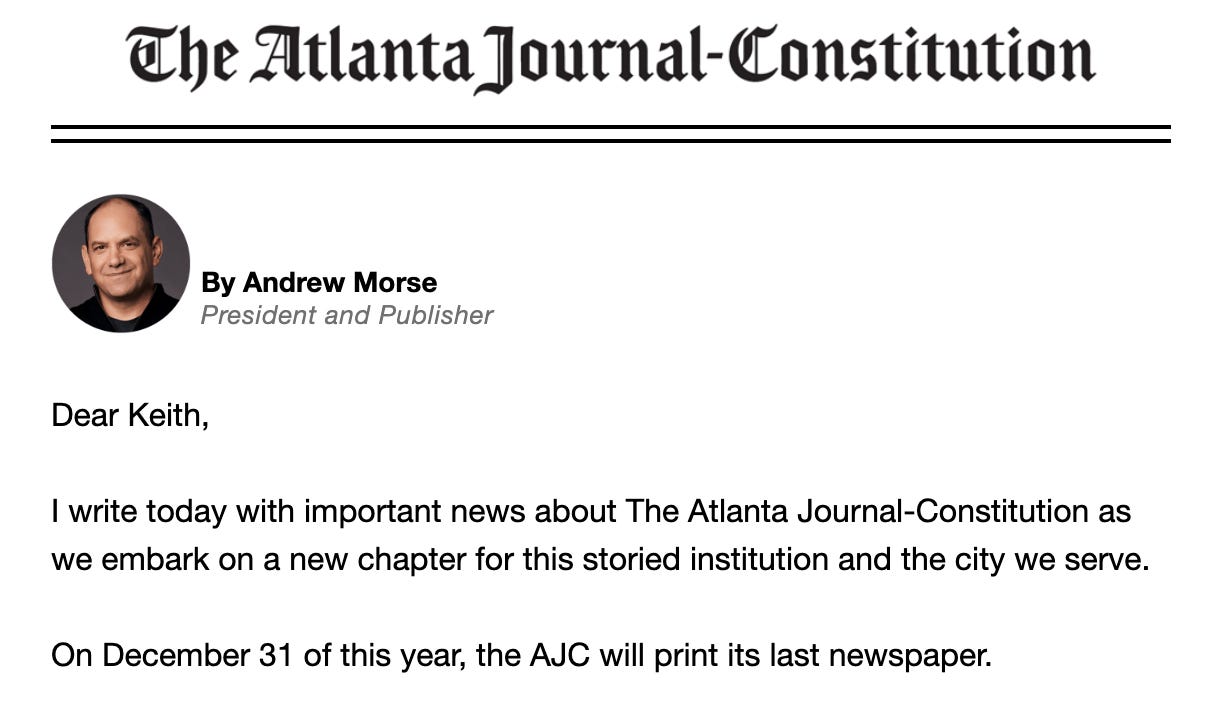AJC nixes print. What the what?!
A Pinch of Pepper
Well, I didn’t expect to publish two of my supposedly “periodic” columns in the first week, but there are apparently no boring news days in the news business.
Click here to read my previous Publisher’s Note on the challenges and opportunities of print.
Earlier today, the 157-year-old Atlanta Journal-Constitution announced that it would cease printing (“cold turkey,” as the Times put it when it broke the news, online, naturally) at the end of the year.
Hot take
The news alert hit my phone as I left a meeting. Within minutes, my texts lit up. One friend, a longtime reader, compared it to losing his 94- and 97-year-old parents: “I knew they were going to die, but I just still felt so sad.”
I spoke to the AJC’s President and Publisher, Andrew Morse, on the phone about two hours after the news broke. He stressed this decision wasn’t about money — the print edition was profitable — but about the bandwidth it consumed. He said that “every dollar, every person, and every ounce of bandwidth should be focused on the journalism and then getting it to people in the most effective way possible.”
“There wasn’t a business case for it. There wasn’t a customer case for it.”
It’s been clear for some time that the loading of a pallet of papers onto a truck and driving door-to-door to throw it onto driveways was not the most effective way possible.
He told me that on election night last year, AJC.com had 450,000 visitors consuming real-time results and analysis, while only 24,000 households got the next morning’s print edition, which was more than half a day old at that point.
Everybody calm down
When nostalgia is the only reason to keep something alive, I don’t think this decision should have been very hard, even though I know change is difficult. Morse’s calculus is that journalists being free of the print deadlines “will allow them to do even more distinctive work.”
I’m as competitive as anybody, and I love the days when our newsletter has something before the AJC or others (and sulk when we get beat), but as I wrote two days ago, we should all root for the AJC, still the largest newsroom in the South, to thrive. Spinning this news any other way is not a good narrative for the industry and is either disingenuous or shows a dangerous misunderstanding of the modern media business.
What’s next?
I asked if the AJC had considered a reduced print schedule, and we both agreed that the few-days-a-week model that many papers have gone to is not the answer. That said, Morse left the door open for a future print product that “taps into people's rhythms and gives them an opportunity to lean back with some of our best content.”
That could look something like a bi-weekly magazine or a monthly print product along the lines of what Rough Draft produces. There are use cases for print, it’s just not a daily newspaper.
Things nobody asked
For the two decades I lived in New York, I was a daily print subscriber to The New York Times and Sunday New York Post. For many of those years, my Sundays were defined by standing in line for brunch, reading the paper on the sidewalk.
Here’s my list of places in Atlanta I’d wait for brunch, reading the news on my phone, of course:
Elektra at the Forth Hotel - Order the breakfast hummus.
Manuel’s Tavern - You may actually see people reading the paper.
Daily Chew - When you want to feel like you’re in Cape Town or Sydney.
Until next time, thanks for reading!
- KP (keith@roughdraft.news)






